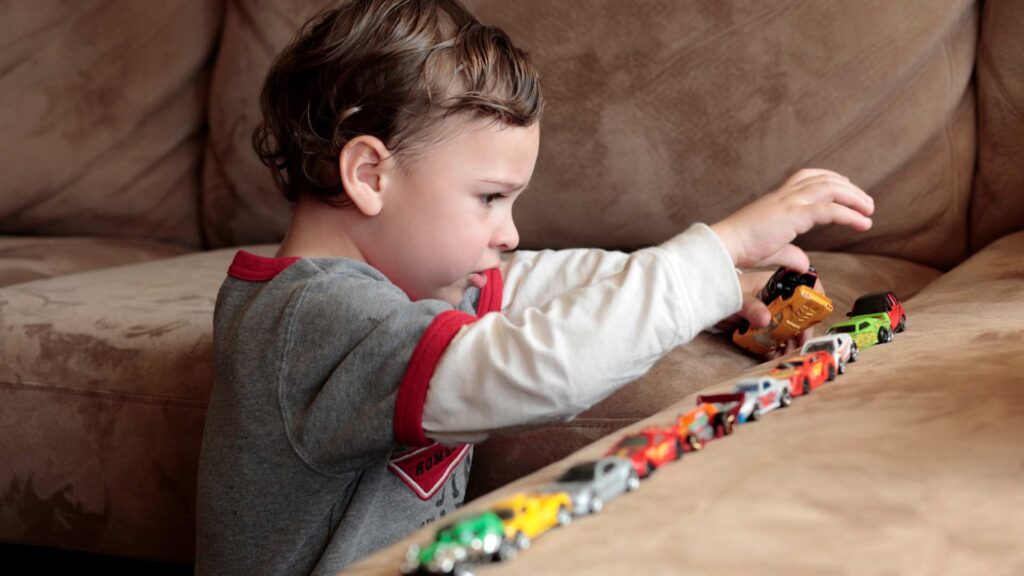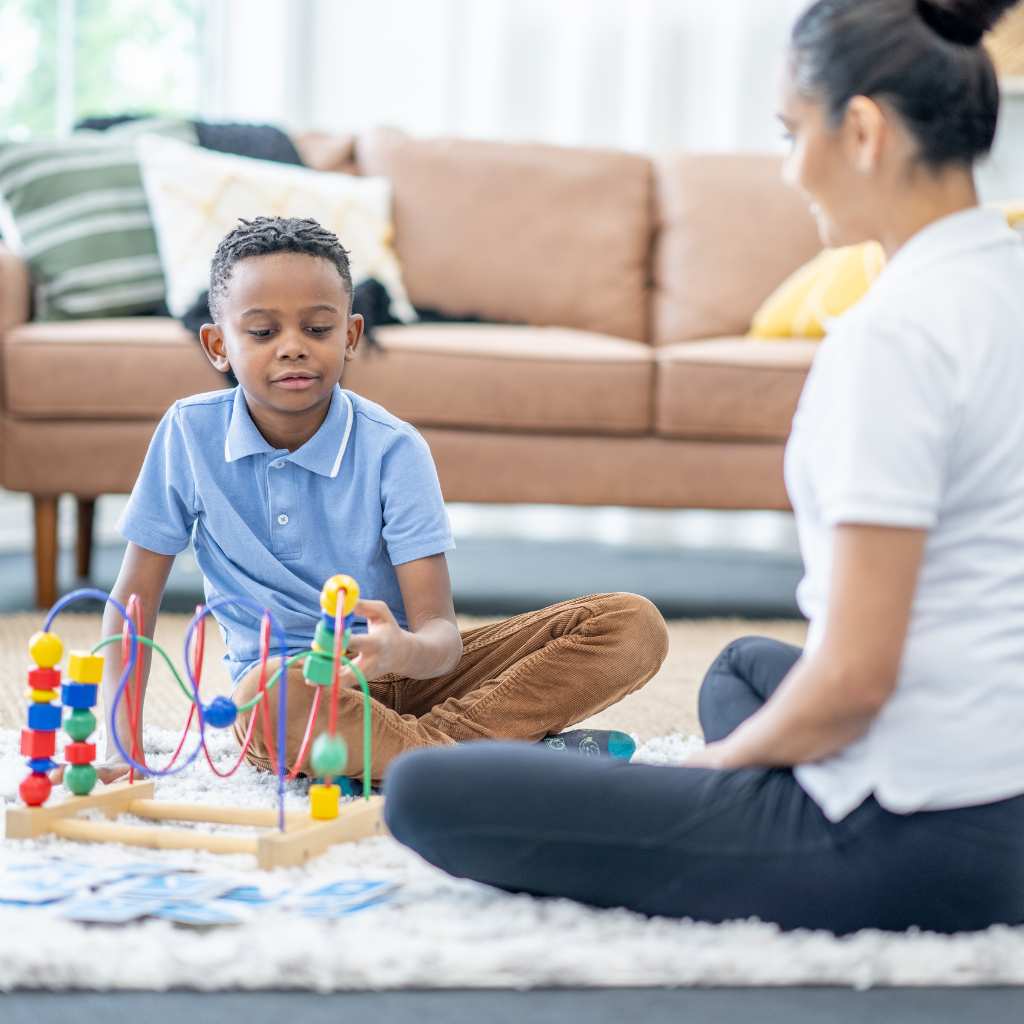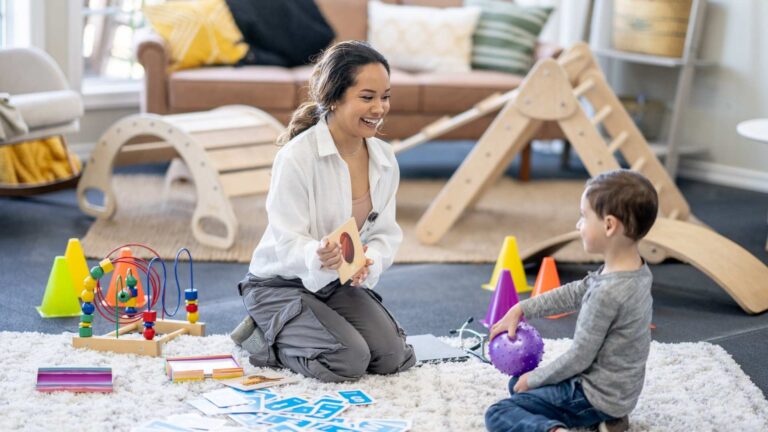Table of Contents
How do kids with ASD play?
Play is a natural part of every child’s life. Do you remember when you were a kid, and your imagination turned a few pillows into a towering castle? Or maybe a cardboard box into a rocket ship and your least favorite toy into the villain of the story? Play fuels creativity, social learning, and development. However, play in autism can look a bit different. Many children on the spectrum may find it challenging to engage in imaginative worlds or follow the rules of a structured game.
So, how do kids with ASD play? While they might face hurdles in areas like communication and social interaction, children with autism also have unique preferences that reflect their interests, skills, and ways of engaging with the world around them. Play becomes a way for them to express themselves, even if it doesn’t follow the traditional forms we’re used to.
In this blog by ABA Centers of Connecticut, we explore play in autism. We uncover the most common challenges on the spectrum when it comes to playing and provide helpful strategies for parents in New Haven, Hartford, Shelton, and other areas of Connecticut.
Is There a Difference of Play in Autism?
 Play is an essential part of a child’s development, helping them build social skills, communication, and creativity; according to the World Journal of Clinical Pediatrics, in childhood, children spend about 3 to 20 percent of their day playing. For children with ASD, play can look different due to their unique ways of processing the world. For many, structured activities or repetitive play patterns are more appealing than imaginative or social games. For example, while neurotypical children might engage in make-believe, a child with autism may focus on lining up toys or repeatedly spinning the wheels of a car.
Play is an essential part of a child’s development, helping them build social skills, communication, and creativity; according to the World Journal of Clinical Pediatrics, in childhood, children spend about 3 to 20 percent of their day playing. For children with ASD, play can look different due to their unique ways of processing the world. For many, structured activities or repetitive play patterns are more appealing than imaginative or social games. For example, while neurotypical children might engage in make-believe, a child with autism may focus on lining up toys or repeatedly spinning the wheels of a car.
These differences don’t mean that children with autism don’t enjoy playing; they simply engage in it in a way that reflects their interests, sensory needs, and developmental stage.
Challenges of Playing in Autism
As we said at the beginning of this article, children with autism navigate the world differently, which sometimes creates some challenges for them, even in the “simple things,” like playing with others or understanding social cues.
In this sense, children with autism may experience the following challenges when it comes to play:
Difficulty with Imagination: Many children with autism struggle with imaginative play, which can make traditional games harder to enjoy or understand.
Social Interaction: Playing with others requires an ability to read social cues, share, and take turns—skills that can be challenging for those on the spectrum.
Sensory Sensitivities: Loud noises, bright lights, or certain textures may overwhelm a child with ASD, making it difficult for them to engage in play in specific environments.
Repetitive Behaviors: Children with autism may find comfort in repetitive play, such as stacking blocks in a specific way or focusing on one toy for an extended period. While these behaviors can be soothing, they may limit exposure to other forms of play that build social or cognitive skills.
Promoting Play Skills in Children with Autism
Even though children with autism face particular challenges with play, there are effective ways to promote their play skills. Keeping in mind this activity is essential as it promotes many valuable abilities through play, including social interaction, communication, and problem-solving skills.
Follow their lead: Start with activities that your child naturally enjoys. If they like building, join them and gradually introduce new ways to play with the same toys.
Use visuals: Many children with autism respond well to visual supports. Try showing pictures or videos to give them ideas, or use picture cards to explain the steps of a game.
Encourage joint play: Start with simple activities that involve taking turns, like rolling a ball back and forth. This activity helps introduce social play without overwhelming them.
Incorporate sensory-friendly toys: Toys that cater to your child’s sensory preferences—like weighted blankets, textured blocks, or toys with soft lights can keep them engaged and comfortable during playtime.
6 Tips for Helping Your Child Enjoy Play
Do you feel like it’s hard to get your child to enjoy playing, even by themselves? We understand that parenting, especially raising a child with autism, is no easy task. It’s completely normal to feel discouraged or lose hope over minor frustrations, like when your child doesn’t seem to enjoy play or has trouble interacting with other kids during play.
As a parent, it’s natural to worry because you want your child to connect with others and make friends.

But remember, there’s always hope and new ways to teach skills. At ABA Centers of Connecticut, when parents come to us concerned that their children aren’t playing, we always offer a few helpful suggestions, including:
1. Be patient: It’s essential to go at your child’s pace. Play may not come naturally at first, but patience and consistency can lead to progress.
2. Model play behaviors: Show your child how to play by demonstrating actions they can mimic. This imitation can help them learn new ways to engage with toys and other people.
3. Use praise and encouragement: Celebrate small victories! Positive reinforcement helps motivate children to try new forms of play.
4. Set up a play routine: Predictability is helpful for children with autism. Creating a structured play schedule can help them feel secure and know what to expect.
5. Provide options: Let your child choose from a few activities so they feel in control and they’re more likely to engage when they pick something they like.
6. Seek professional support: Sometimes, getting help from a therapist to work on play skills through ABA therapy can make a big difference.
Learning Through Play with ABA Therapy
Clinicians and autism centers always recommend Applied Behavior Analysis (ABA) for its ability to help children with autism develop critical life skills, including those related to play. BCBA and RBT use positive reinforcement to encourage desired behaviors, such as initiating play or engaging with others. By incorporating play into therapy sessions, therapists can help children with autism build social, communication, and cognitive skills in a way that feels enjoyable and less structured.

Playtime in ABA therapy might involve role-playing, turn-taking, or using toys to develop problem-solving skills. This type of learning is particularly effective because it taps into the child’s natural motivation to play, making the learning process more engaging.
ABA Centers of Connecticut Supports Your Kids Development
At ABA Centers of Connecticut, we pride ourselves on promoting positive behaviors while reducing the more challenging behaviors present on the spectrum. We know that play in autism is essential not only for your little one’s enjoyment and recreation but also for generating valuable skills and even friendships that can last a lifetime.
If you need more professional and behavioral guidance, feel free to call us at (844) 395-0448 or schedule a free appointment to explore our ABA therapy services.
Together, we can create a plan that fosters development through play.









